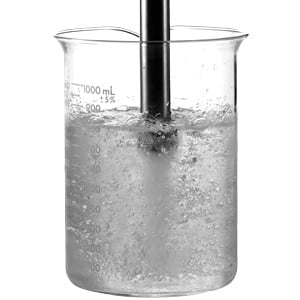
There are several methods used in life science laboratories to break open cells (a.k.a. achieve cell lysis) and access the materials within (e.g. DNA, proteins, organelles, proteins, DNA, mRNA, etc.). One such method is sonication.
What is Sonication?
Sonication breaks open cells via the process of sonochemistry. A metal probe is immersed in the sample containing the cells. A power source attached to the probe, which generates sound energy typically in the 20-50kHz range.
This sound energy is then converted via the ultrasonic probe into mechanical energy, which causes an implosion of tiny bubbles in the sample. This is known as “cavitation”, and is what ultimately triggers cell rupture and enables cell lysis.
Note that another, somewhat less common application of sonication is by using an ultrasonic bath instead of an ultrasonic probe.
Limitations of Sonication
While sonication is a common method for achieving cell lysis, it is not without drawbacks and limitations; some of which are significant. Here is a snapshot of some of these weaknesses:
- Accessibility: Because it unleashes a violent implosion of “bubbles” in the cell culture sample – increased temperatures can result in denaturing proteins. As such, it is not suitable for less resistant cells.
- Efficiency: Sonication may require numerous short runs for larger samples, and therefore may be inefficient.
- Costs: Because of the added time investment and the risk damaging the cell wall, relative to other methods sonication is not a cost-effective process, and is not an in-line process.
- Yield: Sonication can lead to variations in yield, due to the nature of random vibrations. This can impede the ability to develop a consistent manufacturing protocol.
- Contamination: Sonication generates free radicals, which can react with other molecules and cause contamination.
- Configuration: Sonication equipment must be optimized (time, power) for each cell type. This can be inefficient and lead to added time and costs.
Pion High Pressure Homogenizers
Researchers in life science laboratories who want to avoid these drawbacks and limitations of sonication are invited to learn more about Pion's BEE brand High Pressure Homogenizers, which are suitable for different cell disruption strategies (e.g. gentle, harsh). They are also efficient and deliver high yields in less time, and scale to allow researchers to go from small samples to larger clinical trials, but without impeding the ability to reproduce results.
Learn more about Pion's High Pressure Homogenizers by clicking here.

